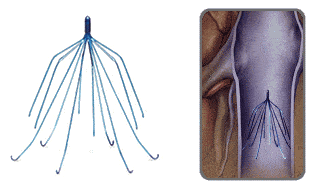Deep Vein Thrombosis (DVT) Treatment
Deep vein thrombosis is a serious condition where a blood clot forms in the deep veins of the leg. Initial treatment for DVT is fairly routine and involves a regimen of blood thinners. However, more complex cases of DVT may require a vascular surgeon. These are the various DVT treatment protocols that may be employed to treat deep vein thrombosis.
Blood Thinners
Blood thinners are typically the first line of treatment for DVT. They don’t necessarily thin the blood, but they work by preventing platelet blood cells from clumping together to form clots. Blood thinners can have serious side effects to they are typically used when the benefits outweigh the risks. Blood thinners for treating DVT fall in to two categories: Anticoagulants and anti-platelets. Anticoagulants hinder the chemical process required to form clots and slow the process down. They include:
- warfarin (Coumadin)
- dabigatran (Pradaxa)
- rivaroxaban (Xarelto)
- apixaban (Eliquis)
Anti-platelets prevent platelets from clumping together and forming clots. These medications include:
- aspirin
- clopidogrel (Plavix)
- prasugrel (Effient)
- ticagrelor (Brilinta).
IVC Filter
In some patients, blood thinners are not an option to treat dvt. Blood thinners thin blood in all locations of the body, not just the leg, so they can cause bleeding. For example, trauma patients with dangerous injuries like bleeding in the brain, cannot receive blood thinners. Patients who are prone to bleeding from their GI tract (intestines and stomach) may have difficulty with blood thinners. In these patients, DVT is especially dangerous, because without blood thinners, there is a greater likelihood that the clot will float into the lungs, causing a pulmonary embolism.
 In this case, vascular surgeons are often called to place an IVC filter. The filter is a small device which is placed in the largest vein in the body – the inferior vena cava. The filter will catch any significant clot, and prevent the clot from traveling into the heart and out to the lungs. In this way, even patients who cannot have blood thinners can avoid a serious or fatal pulmonary embolism. The IVC filter is placed through a tiny opening either in the neck (jugular vein) or the groin (femoral vein). Advanced x-rays are used to aid doctors in placing the filter exactly where it will be effective in the inferior vena cava.
In this case, vascular surgeons are often called to place an IVC filter. The filter is a small device which is placed in the largest vein in the body – the inferior vena cava. The filter will catch any significant clot, and prevent the clot from traveling into the heart and out to the lungs. In this way, even patients who cannot have blood thinners can avoid a serious or fatal pulmonary embolism. The IVC filter is placed through a tiny opening either in the neck (jugular vein) or the groin (femoral vein). Advanced x-rays are used to aid doctors in placing the filter exactly where it will be effective in the inferior vena cava.
Compression
For patients with a large DVT associated with significant swelling and/or pain, or DVT’s which extend into the pelvis (iliofemoral DVT’s), there is a significant risk of long term symptoms of venous insufficiency in the affected leg. The venous insufficiency in this case occurs because of failed valves in the deep veins in the leg. These patients can experience extreme swelling, pain, and severe changes of chronic venous insufficiency. When this happens as a result of clots in the veins, it is called post-phlebitic syndrome. Post-phlebitic syndrome is chronic, debilitating, and treatable mainly with compression.
Thrombectomy
In patients with extensive DVT’s, optimal treatment has two goals. The first goal is to prevent a pulmonary embolism using blood thinners The second goal is to try to decrease the risk of post phlebitic syndrome. In order to reduce this risk, removal of the venous clot can be performed. This procedure is called a venous “thrombectomy,” and it can be performed using a number of different techniques.
Other Techniques
Other techniques can also be employed to break down and remove venous thrombus. Most of these techniques are minimally invasive, and very effective if done in a timely manner. Qualified vascular surgeons like Dr. Aquino can determine the safest and most effective technique for clot removal in this situation.
